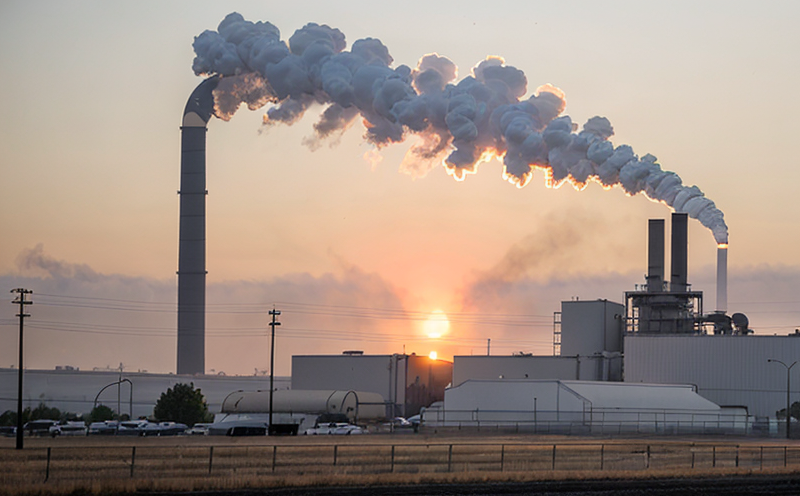ISO 23438 Nitrous Oxide Testing in Industrial Facilities
The testing of nitrous oxide (N₂O) emissions at industrial facilities is critical to ensuring compliance with international standards and regulations designed to protect both human health and the environment. ISO 23438 specifically addresses the measurement of nitrous oxide emissions, which are a significant greenhouse gas that contributes to global warming. This service focuses on providing comprehensive testing solutions for industries such as manufacturing, chemical processing, and waste management.
Our laboratory adheres strictly to the ISO 23438 standard, ensuring accurate and reliable measurements. The process begins with thorough sampling of air streams from industrial processes known to emit N₂O. Samples are collected using specialized equipment that ensures minimal loss or contamination during collection. Once collected, samples undergo rigorous analysis in our state-of-the-art laboratory, equipped with advanced instrumentation capable of detecting even trace levels of nitrous oxide.
The testing procedure involves several key steps: first, the sample is prepared and transferred to a gas chromatograph for precise measurement. The gas chromatograph separates the different components of the sample based on their chemical properties, allowing for accurate quantification of N₂O. Following analysis, results are compared against internationally recognized thresholds set by ISO 23438. Any deviations from these standards are flagged immediately and thoroughly investigated to identify potential sources of non-compliance.
Our team of experienced analysts ensures that all tests meet the highest quality standards. We employ a multidisciplinary approach, combining expertise in environmental science with cutting-edge analytical techniques. This allows us to provide not only accurate test results but also actionable insights into how facilities can reduce their N₂O emissions and improve overall sustainability.
Industries like manufacturing and chemical processing often rely on processes that inadvertently produce nitrous oxide as a byproduct. By implementing ISO 23438 compliant testing, these industries gain valuable data that helps them optimize operations to minimize environmental impact. Our services are particularly beneficial for companies looking to achieve certification under various green initiatives or meet specific regulatory requirements.
Our commitment to providing accurate and reliable testing extends beyond mere compliance. We offer strategic advice based on our findings, helping facilities understand the implications of their emissions levels and explore opportunities for improvement. This proactive approach ensures that clients remain ahead of changing environmental regulations while enhancing their reputation as responsible corporate citizens.
In conclusion, ISO 23438 nitrous oxide testing is essential for any industrial facility aiming to maintain regulatory compliance and contribute positively to global efforts against climate change. By leveraging our expertise in this area, we empower businesses to make informed decisions that benefit both the environment and their bottom line.
Benefits
Implementing ISO 23438 nitrous oxide testing brings numerous advantages to industrial facilities:
- Regulatory Compliance: Ensures adherence to international standards, reducing the risk of penalties and fines.
- Environmental Stewardship: Helps identify and mitigate sources of N₂O emissions, contributing to a healthier planet.
- Data-Driven Decisions: Provides actionable insights that enable facilities to optimize processes for greater efficiency and sustainability.
- Certification Opportunities: Facilitates the attainment of certifications from recognized bodies, enhancing a company's reputation.
In addition, our testing service supports compliance with local and international regulations such as those outlined in ISO 23438. This not only helps facilities avoid legal issues but also fosters trust among stakeholders by demonstrating commitment to environmental responsibility.
International Acceptance and Recognition
The International Organization for Standardization (ISO) has developed the ISO 23438 standard, which provides guidelines on how to measure nitrous oxide emissions accurately. This standard is widely accepted across countries due to its stringent requirements and emphasis on precision.
- Global Adoption: Countries like the United States, Canada, Europe, Australia, and Japan have all adopted ISO 23438 as a benchmark for measuring nitrous oxide emissions in industrial facilities. This widespread adoption underscores its reliability and effectiveness.
- Auditing Bodies: Many auditing firms use ISO 23438 during audits of companies involved in manufacturing or processing activities that could potentially produce N₂O emissions.
The standard's global recognition means that facilities adhering to it can more easily export products internationally, as many importing countries require compliance with these standards. Additionally, adherence enhances a company’s reputation and marketability, attracting customers who value environmental responsibility.
Competitive Advantage and Market Impact
ISO 23438 nitrous oxide testing offers significant competitive advantages for industrial facilities:
- Enhanced Reputation: Demonstrating compliance with international standards can significantly boost a company's image, making it more attractive to investors and consumers.
- Increased Market Access: Compliance facilitates entry into markets that have stringent environmental regulations. This is particularly valuable for companies looking to expand their global footprint.
- Cost Savings: Early identification of emissions hotspots through testing can lead to process improvements, reducing long-term operational costs.
The competitive landscape in industrial manufacturing and processing is increasingly focusing on sustainability. Companies that can demonstrate leadership in minimizing N₂O emissions are likely to gain a significant market edge over competitors who lag behind in adopting such practices. This translates into improved business performance and greater resilience against environmental regulations and changing consumer preferences.





